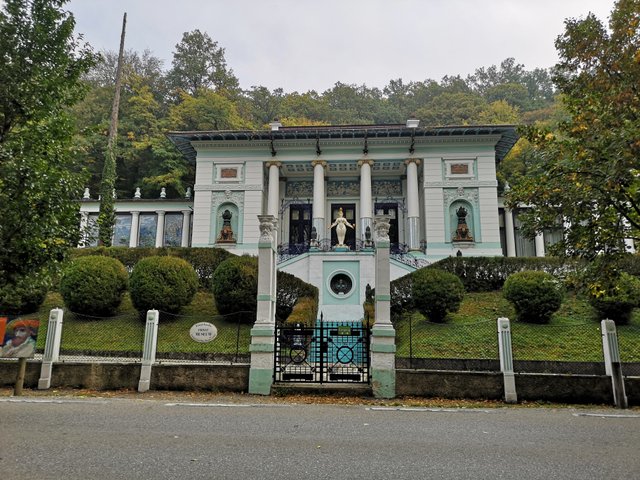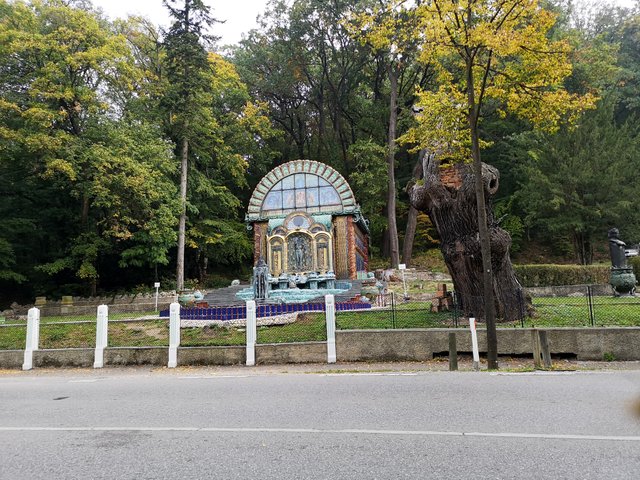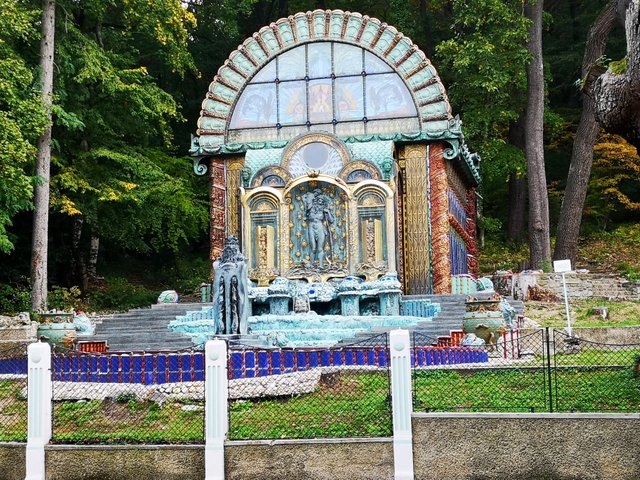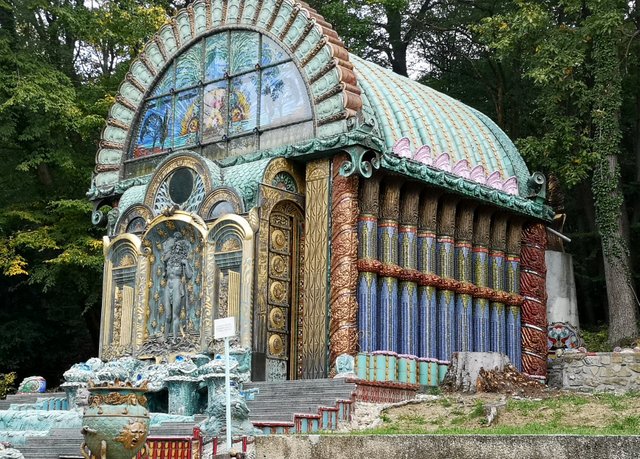THE OTTO WAGNER VILLA IN VIENNA
Otto Wagner, the famous Art Nouveau architect built in 1888 for himself and his family in Hütteldorf, a former Viennese suburb, a sumptuous summer palace. His favorite architect, Palladio, was the inspiration for the residence, which was kept in the style of historicism. Simultaneously with the construction, the project was presented by Wagner at some European architecture competitions and attracted international attention.
"The artist's own villa develops a peculiar charm in Hütteldorf near Vienna. Completely deviating from the usual appearance of similar buildings, the building erected on a hillside and accessible by a stately staircase at the front view shows only an open hall between two wing constructions, "was the comment on the drafts in Berlin.
As early as 1895, the right side wing, the orangery, was made winter-proof with transparent glass windows and now served Otto Wagner and his guests as a billiard salon.
In 1900, the left side wing was rebuilt and designed by Otto Wagner to become the most beautiful Art Nouveau hall in Vienna. All the details have been preserved, especially the magnificent large Tiffany glass windows by Adolf Böhm. After this - now forgotten artist friend of Otto Wagner - the "Adolf Böhm-Saal" is named.
Until 1911, the Villa Otto Wagner served as a representative house. As part of legendary receptions and summer festivals, the elegant Viennese society met here. Artists such as Gustav Klimt, the Wagner student Josef Hoffmann, Adolf Loos, Gustav Mahler, Alma Mahler-Werfel and many others went out and in the elegant Otto Wagner Villa. After the completion of the planning of his large, public projects, such as the Wiener Stadtbahn, the Postsparkasse and the church am Steinhof, Otto Wagner built on the adjoining property of the villa a modern smaller villa in functional Art Nouveau, which he was to live in for only three years. The large villa was sold in 1912 to Ben Tiber, the director of the Vienna Apollo Theater and the Ronacher Revue Theater. He was a wealthy investor and continued to hold legendary festivals in the Otto Wagner Villa.
On the run from the Nazi socialists, Ben Tiber emigrated abroad in the mid-30s. The villa was expropriated. During the Second World War, the Otto Wagner Villa was converted into an office headquarters for Baldur von Schierach. The leisure activities of the Hitler Youth were organized from here. After the end of the Second World War, the villa became a speculative object and was eventually demolished. However, his strange fairy-tale magic did not "lose this remarkable mansion in the Halterthal", as in 1962 the Austrian poet Heimito von Doderer wrote in his last novel "Grenzwald": "Here was a house right above the street on the slope, actually a house Palace, as such a large number did not exist. The flat roof floated and shaded on high, mighty pillars, and on the left and on the right, the heavy center-building, leaning over its terrace, threw off almost delicate, slender wings, the walls of which, at first sight, consisted only of colored glass, divided by narrow pillars. "
THE MUSEUM
Known today as the Ernst Fuchs Museum, the Otto Wagner Villa is a valuable architectural monument, which was long threatened with decay and eventually was to be demolished. That this did not happen, the villa owes its present owner, the "Heros Eponymos", the draftsman, painter, sculptor and architect Ernst Fuchs.
Ernst Fuchs discovered the deserted villa at the end of the thirties. At that time a poor child, he promised his mother to give her the house once he became a rich painter. For over three decades he kept an eye on the Otto Wagner Villa. In the sixties, he initiated a rescue operation with his fellow painters Friedensreich Hundertwasser and Arnulf Rainer. But no one had the courage to support him. In 1972 he finally acquired from his own resources the enchanted building. He not only saved the Otto Wagner villa from demolition, but also renovated it
Much of the villa has been restored and redeveloped in the spirit of Otto Wagner. Since the interior was no longer conserved, furniture and wallpaper, door handles and other items were designed and supplemented by Ernst Fuchs' designs.
Until 1986, the Fuchs Villa, the legendary founder of the Vienna School of Fantastic Realism, served as a studio. Famous people such as Placido Domingo, Edward Teller, Oskar Werner and Falco were portrayed here by the master. Grace Kelly, Curd Jürgens and Yoko Ono visited their artist friend Ernst Fuchs here. In 1988, Ernst Fuchs fulfilled his lifelong dream. The Ernst Fuchs Museum was opened, opening the doors of the Otto Wagner Villa to visitors from all over the world. Throughout the year you can now visit their magnificent rooms. A retrospective on the artistic work of Ernst Fuchs leads chronologically through the rooms of the Bel Etage and the first floor.
Not only early drawings from the 40s, precious miniature paintings from the 50s, the great pencil drawings from the 60s, but also monumental paintings like "The Sign of Moses" from 1978 can be viewed here daily in the original The Roman bath with mosaics by Kolo Moser and the unique watercolor cycle "Lohengrin" by Ernst Fuchs, as well as the small gallery with painted and carved furniture, sculptures and precious graphics by the master can be seen in a guided tour, as well be visited by individual guests.
The symbiosis between Otto Wagner and Ernst Fuchs is described by Marcel Brion in an essay that can be found in the bibliophile museum catalog. Here he describes Ernst Fuchs as a "visionary who sees through things" as a "chronicler of unknown worlds". "Not a certain ancient or modern myth, but Ernst Fuchs's own mysticism in which all or almost everything resonates in his work; not religious history education, not a skilful historical representation of an academic painter, but a mythology without role models, which includes them all, culminating in a hybrid marriage of hybrids, invented or found by himself, melting pot of faith and intuitions, superstitions and liturgies, enlightenments and Nightmares, barely anticipated and seerically sensed. A world of its own, a true world. "Fox over Fox, Marcel Brion, 1978 Piper Munich:
ERNST FOX - AN AWESOME LIFE
Ernst Fuchs was born in Vienna Ottakring in 1930 as the only child of Leopoldine and Maximilian Fuchs. The father emigrated to Shanghai in 1938 for political reasons. Mother and son stay in Vienna. Twelve-year-old Ernst Fuchs is baptized in St. Stephen's Cathedral in Vienna and avows to the Roman Catholic faith. Since he is not allowed to attend high school due to racist reasons, he receives private lessons, especially in sculpture and painting. In 1945, after the end of the war, he enrolled in painting at the Vienna Academy of Fine Arts.
His role models are Gustav Klimt, Egon Schiele, Pablo Picasso and Max Ernst. Professor Albert Paris von Gütersloh promotes the talent of the young Ernst Fuchs. In his class also the first meeting of Ernst Fuchs with Arik Brauer, Rudolf Hausner, Wolfgang Hutter and Anton Lehmden takes place. The "Vienna School of Fantastic Realism" is forming. The painting of the Renaissance - especially the Danube School - should be redefined. Alchemy, Christian and Jewish mysticism, but also deep psychological, such as the processing of pain and suffering of the world wars, determine the theme worlds of the young artist group. Ernst Fuchs makes his name with cycles of expressionist charcoal drawings and gouaches, including the "City Cycle" in 1945 and the "Bikini Atoll Cycle" in 1947.
With these works, he also participates in the first post-war Biennale in Venice. In 1947 he traveled to Turin, where he met Felipe Casorati, Giorgio de Chirico and his brother: the most important painters of Pittura Metaphisica. Despite bitter poverty and difficult private circumstances, in 1949 he followed his friend Friedensreich Hundertwasser - then Fritz Stowasser - to Paris. He will spend twelve of his most important creative years in what was then the mecca of art. He leaves his first wife Trude in Vienna with his two sons Elias and Daniel Friedemann. In Paris Ernst Fuchs takes advantage of his knowledge of the painting techniques of the old masters. In the absence of an atelier he paints at night in coffee houses. In the picturesque St.Germain des Près everyone soon knows the young, beautiful foreigner. Jean Paul Sartre, Jean Cocteau and especially Salvadore Dali admire his miniature paintings. Fuchs works on his famous cycles "Metamorphosis of Creature" and "Unicorn Cycle".
In 1953 he follows his second wife Geri Krongold to New York and Los Angeles. This is followed by encounters with Peggy Guggenheim and jazz legends such as Charlie Parker and Moondog, whom he supports 30 years later in Germany. He lives in a tree house near Los Angeles with Dave Brubeck. On the west coast, the young fox becomes the guru of a new young art scene. He inspires airbrush and fantasy painting.
In 1956, Ernst Fuchs moved to Israel. He is admitted to the Catholic Dormition Monastery, where he works for a year on his largest painting, the "Last Supper," in the refectory.
In 1961, back in Vienna, he marries for the third time. With new pictorial worlds interwoven by Eros and myth he succeeds in the breakthrough in the art world. Erotic, monumental bronzes such as "Hypnosia" and "Esther" are created. Ernst Fuchs designs architecture, furniture, wallpaper and jewelery for his beautiful young lady Eva-Christina. The couple becomes the style icon of the sixties. Soon his käppi and from 1970 his golden Rolls-Royce become Ernst Fuchs' trademark.
Exhibitions of the five artists of the "Vienna School of Fantastic Realism" are shown in Japan, Los Angeles, New York and Paris. They are quickly the stars at the international art fairs. In 1972, Ernst Fuchs acquires a Jugendstil jewel threatened with demolition, the first Otto Wagner Villa in Vienna Hütteldorf. The restoration works take two years, then one of the most beautiful ateliers in Europe opens its doors with self-designed wallpaper, furniture, sculptures, chandeliers and paintings. But the painter-prince travels extensively, designs stage sets for the Hamburg and Munich operas, and works for months in Italian and German foundries on the completion of his famous small sculptures such as "Sphinx" and "Janus." In addition to large-format oil painting compositions in Vienna, he works He travels past pastels, watercolors and drawings, and two magnificent volumes bear witness to the fuchsian visual worlds of the seventies and eighties: "Feuerfuchs" and "Planeta Caelestis".
In 1988, one hundred years after its construction by Otto Wagner, the Wagner Villa becomes a Ernst Fuchs private museum. A retrospective of his work from 1945 to the present is shown here. But the artist does not keep it in Vienna. Ernst Fuchs moves to southern France and works on large painting cycles such as "Dionysus" and various architectural designs. His prototype is the "Nymphaeum Omega" in the park of his Viennese museum, the Fuchs Villa, a fountain house with a huge Madonna window in the interior, adorned by the twelve golden angels of the Apocalypse.
In 1989, Ernst Fuchs began his work at the Apocalypse Chapel in Klagenfurt. It should take almost twenty years to complete. Hundreds of square meters of canvas and stucco are painted in the old master technique.
Ernst Fuchs writes time of his life. The poetry book "Von Jahwe", illustrated with precious lithographs, is published in the 90s. Fuchs sings himself in the records "Via Dolorosa" and the CD "Mystische Gesänge". Writings on architecture can be found in "Architectura Caelestis". Erotic and essayistic comes in the novel "Aura", numerous lectures, essays and short stories and before. Between 1990 and 2003, the artist's extensive retrospective is shown in international museums, including the Russian Museum in St. Petersburg, the Tretyakov Gallery in Moscow and the Harrach Palace, which is part of the Kunsthistorisches Museum in Vienna.
Ernst Fuchs lives and works in Vienna.
Ernst Fuchs dies looking back on a fulfilled fantastic life on November 9, 2015 in Vienna.






I upvoted your post.
Keep steeming for a better tomorrow.
@Acknowledgement - God Bless
Posted using https://Steeming.com condenser site.
Oh my goodness, this is sooooo beautiful, I would love to see it inside 💛😊💛
Unfortunately, I did not have time to visit them from the inside.
Hello @proanima, thank you for sharing this creative work! We just stopped by to say that you've been upvoted by the @creativecrypto magazine. The Creative Crypto is all about art on the blockchain and learning from creatives like you. Looking forward to crossing paths again soon. Steem on!
Thank you so much, I am happy for your visit and upvote!
Why not using a tag #vienna or #wien, so that you could also get attention and upvotes by the Viennese Steem community?
Many thanks for the tip!